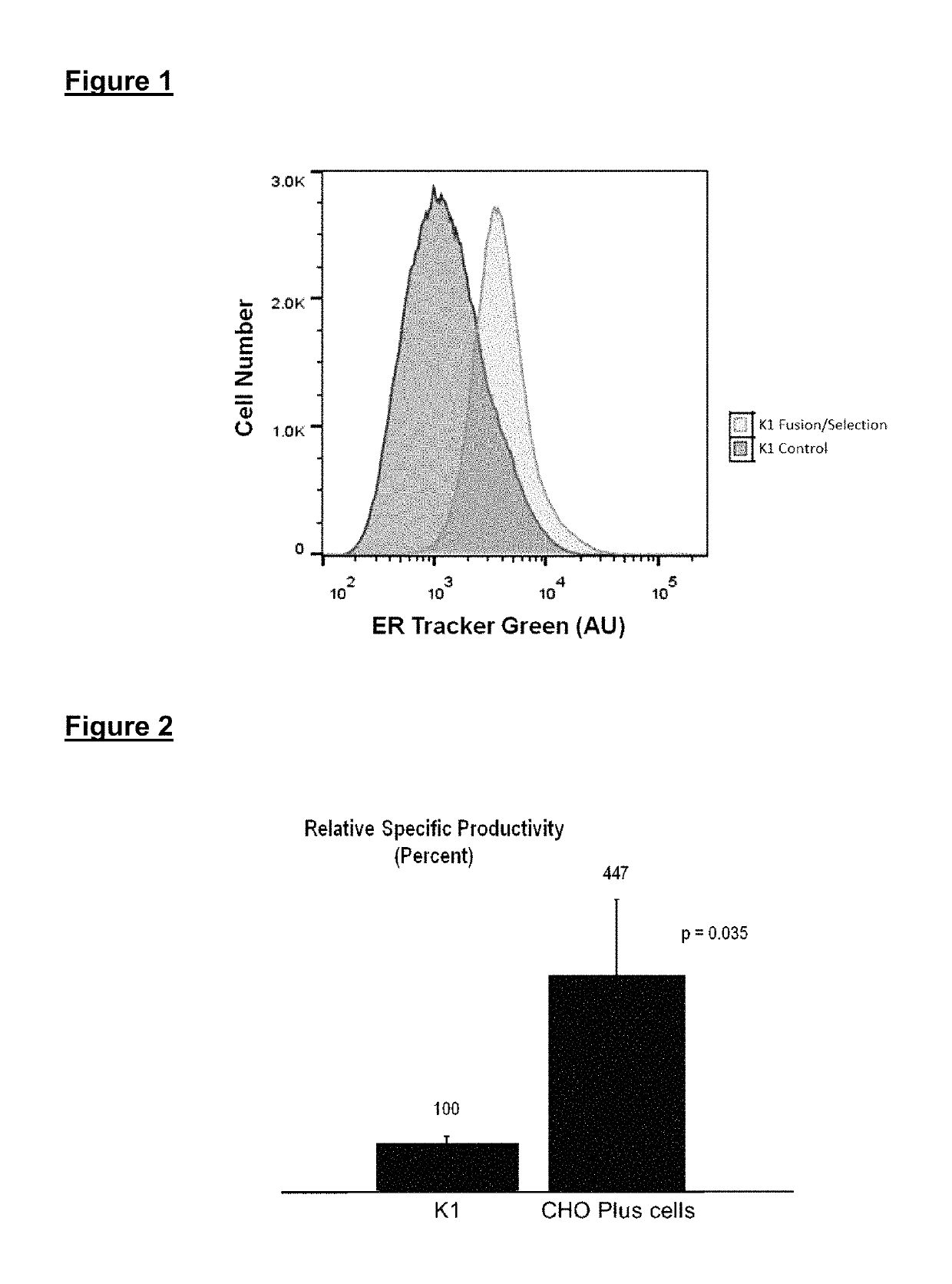Cell lines for high level production of protein-based pharmaceuticals
a protein-based pharmaceutical and cell line technology, applied in the direction of genetically modified cells, instruments, fused cells, etc., can solve the problems of large volume of culture medium, complex infrastructure, and high cost of producing therapeutic proteins, and achieve the effect of increasing the density of subcellular organelles and being stably inheritabl
- Summary
- Abstract
- Description
- Claims
- Application Information
AI Technical Summary
Benefits of technology
Problems solved by technology
Method used
Image
Examples
example 1
[0080]The invention can be practiced using the K1 line of CHO cells as follows. A population of CHO cells is fused so as to make isotopic hybrids according to the following protocol:[0081]1. Centrifuge 107 cells.[0082]2. Discard supernatant[0083]3. Break the pellet by gently tapping the bottom of the tube[0084]4. Add 100 μL of 50% PEG over the period of one minute, while mixing the cells with a pipette tip[0085]5. Continue stirring the cells for one additional minute[0086]6. Add 100 μL of growth medium over one minute while mixing[0087]7. Add 300 μL of growth over three minutes while mixing[0088]8. Slowly add mL. of growth medium[0089]9. Incubate at 37 deg C. for five minutes[0090]10. Centrifuge[0091]11. Re-suspend the pellet in 20 mL of growth medium and transfer to a 125-mL culture flask[0092]12. Culture normally
[0093]Alternatively, an electrofusion procedure is employed using ECM2001 pulse generator (BTX). 107 cells are centrifuged and resuspended in 1 mL of Cytofusion™ Medium C,...
example 2
[0097]CHO-K1 cells were exposed to a PEG-assisted fusion procedure. The cells were allowed to recover for one week, then the procedure was repeated for a total of three times. Following recovery from the third fusion, the cells were stained with vital ER-tracking dye (ER-Tracker™ Green (glibenclamide BODIPY® FL); Invitrogen, E34251) and sorted using a FACSAriaII™ cell sorter (BD Biosciences). Ten percent of the viable population exhibiting the highest amount of staining with ER-Tracker dye was collected. Following a two-week recovery in culture, the cells were exposed to a final fusion, stained with ER-tracking dye, and analyzed using a LSRII™ flow cytometer (BD Biosciences).
[0098]To measure protein production in the fused cells, and the parental CHO population, the cells were transfected to express secreted alkaline phosphatase (SEAP). The transfection was performed as follows:
[0099]1. Centrifuge 106 cells.
[0100]2. Discard supernatant
[0101]3. Resuspend in 100 μL Cell Line Nucleofec...
PUM
| Property | Measurement | Unit |
|---|---|---|
| volume | aaaaa | aaaaa |
| density | aaaaa | aaaaa |
| fluorescent | aaaaa | aaaaa |
Abstract
Description
Claims
Application Information
 Login to View More
Login to View More - R&D
- Intellectual Property
- Life Sciences
- Materials
- Tech Scout
- Unparalleled Data Quality
- Higher Quality Content
- 60% Fewer Hallucinations
Browse by: Latest US Patents, China's latest patents, Technical Efficacy Thesaurus, Application Domain, Technology Topic, Popular Technical Reports.
© 2025 PatSnap. All rights reserved.Legal|Privacy policy|Modern Slavery Act Transparency Statement|Sitemap|About US| Contact US: help@patsnap.com

